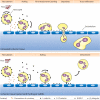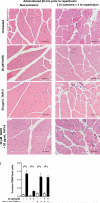Hydrogen sulfide reduces neutrophil recruitment in hind-limb ischemia-reperfusion injury in an L-selectin and ADAM-17-dependent manner
- PMID: 23446563
- PMCID: PMC3587315
- DOI: 10.1097/PRS.0b013e31827c6e9c
Hydrogen sulfide reduces neutrophil recruitment in hind-limb ischemia-reperfusion injury in an L-selectin and ADAM-17-dependent manner
Abstract
Background: Reperfusion following ischemia leads to neutrophil recruitment into injured tissue. Selectins and β2-integrins regulate neutrophil interaction with the endothelium during neutrophil rolling and firm adhesion. Excessive neutrophil infiltration into tissue is thought to contribute to ischemia-reperfusion injury damage. Hydrogen sulfide mitigates the damage caused by ischemia-reperfusion injury. This study's objective was to determine the effect of hydrogen sulfide on neutrophil adhesion receptor expression.
Methods: Human neutrophils were either left untreated or incubated in 20 μM hydrogen sulfide and/or 50 μg/ml pharmacologic ADAM-17 inhibitor TAPI-0; activated by interleukin-8, fMLP, or TNF-α; and labeled against P-selectin glycoprotein ligand-1, leukocyte function associated antigen-1, Mac-1 α, L-selectin, and β2-integrin epitopes CBRM1/5 or KIM127 for flow cytometry. Cohorts of three C57BL/6 mice received an intravenous dose of saline vehicle or 20 μM hydrogen sulfide with or without 50 μg/ml TAPI-0 before unilateral tourniquet-induced hind-limb ischemia for 3 hours followed by 3 hours of reperfusion. Bilateral gastrocnemius muscles were processed for histology before neutrophil infiltration quantification.
Results: Hydrogen sulfide treatment significantly increased L-selectin shedding from human neutrophils following activation by fMLP and interleukin-8 in an ADAM-17-dependent manner. Mice treated with hydrogen sulfide to raise bloodstream concentration by 20 μM before ischemia or reperfusion showed a significant reduction in neutrophil recruitment into skeletal muscle tissue following tourniquet-induced hind-limb ischemia-reperfusion injury.
Conclusions: Hydrogen sulfide administration results in the down-regulation of L-selectin expression in activated human neutrophils. This leads to a reduction in neutrophil extravasation and tissue infiltration and may partially account for the protective effects of hydrogen sulfide seen in the setting of ischemia-reperfusion injury.
Figures




Similar articles
-
Therapeutic metabolic inhibition: hydrogen sulfide significantly mitigates skeletal muscle ischemia reperfusion injury in vitro and in vivo.Plast Reconstr Surg. 2010 Dec;126(6):1890-1898. doi: 10.1097/PRS.0b013e3181f446bc. Plast Reconstr Surg. 2010. PMID: 21124129
-
Neutrophil mediated remote organ injury after lower torso ischemia and reperfusion is selectin and complement dependent.J Trauma. 2000 Jan;48(1):32-8. doi: 10.1097/00005373-200001000-00006. J Trauma. 2000. PMID: 10647562
-
The effect of isoflurane on neutrophil selectin and beta(2)-integrin activation in vitro.Anesth Analg. 2002 Sep;95(3):583-7, table of contents. doi: 10.1097/00000539-200209000-00017. Anesth Analg. 2002. PMID: 12198042
-
Ischemia-reperfusion injury.Agents Actions Suppl. 1993;41:137-52. Agents Actions Suppl. 1993. PMID: 8317338 Review.
-
Mechanisms by which hydrogen sulfide attenuates muscle function following ischemia-reperfusion injury: effects on Akt signaling, mitochondrial function, and apoptosis.J Transl Med. 2019 Jan 21;17(1):33. doi: 10.1186/s12967-018-1753-7. J Transl Med. 2019. PMID: 30665344 Free PMC article. Review.
Cited by
-
Effect of Sodium Thiosulfate Pre-Treatment on Renal Ischemia-Reperfusion Injury in Kidney Transplantation.Int J Mol Sci. 2024 Sep 2;25(17):9529. doi: 10.3390/ijms25179529. Int J Mol Sci. 2024. PMID: 39273476 Free PMC article.
-
Role of hydrogen sulfide in skeletal muscle biology and metabolism.Nitric Oxide. 2015 Apr 30;46:66-71. doi: 10.1016/j.niox.2014.11.012. Epub 2014 Nov 25. Nitric Oxide. 2015. PMID: 25461301 Free PMC article. Review.
-
Fluid shear stress increases neutrophil activation via platelet-activating factor.Biophys J. 2014 May 20;106(10):2243-53. doi: 10.1016/j.bpj.2014.04.001. Biophys J. 2014. PMID: 24853753 Free PMC article.
-
Potential Mechanisms Underlying COVID-19-Mediated Central and Peripheral Demyelination: Roles of the RAAS and ADAM-17.Mol Neurobiol. 2025 Jan;62(1):1151-1164. doi: 10.1007/s12035-024-04329-8. Epub 2024 Jul 4. Mol Neurobiol. 2025. PMID: 38965171 Review.
-
The Modular µSiM Reconfigured: Integration of Microfluidic Capabilities to Study In Vitro Barrier Tissue Models under Flow.Adv Healthc Mater. 2022 Nov;11(21):e2200802. doi: 10.1002/adhm.202200802. Epub 2022 Aug 21. Adv Healthc Mater. 2022. PMID: 35953453 Free PMC article.
References
-
- McCord JM. Oxygen-derived free radicals in postischemic tissue injury. N Engl J Med. 1985;312:159–163. - PubMed
-
- Yan HD, Zhang F, Kochevar AJ, et al. The Effect of Postconditioning on the Muscle Flap Survival After Ischemia-Reperfusion Injury in Rats. J Invest Surg. 2010;23:249–256. - PubMed
-
- Ergun Y, Darendeli S, Imrek S, et al. The comparison of the effects of anesthetic doses of ketamine, propofol, and etomidate on ischemia-reperfusion injury in skeletal muscle. Fundam Clin Pharmacol. 2010;24:215–222. - PubMed
-
- Cowled PA, Khanna A, Laws PE, et al. Simvastatin plus nitric oxide synthase inhibition modulates remote organ damage following skeletal muscle ischemia-reperfusion injury. J Invest Surg. 2008;21:119–126. - PubMed
Publication types
MeSH terms
Substances
Grants and funding
LinkOut - more resources
Full Text Sources
Other Literature Sources
Research Materials
Miscellaneous

